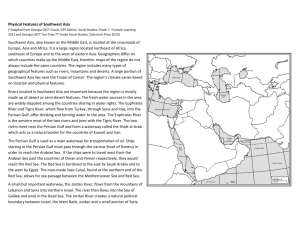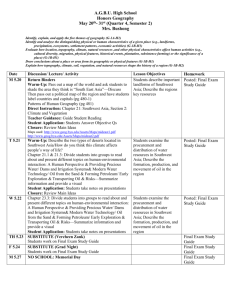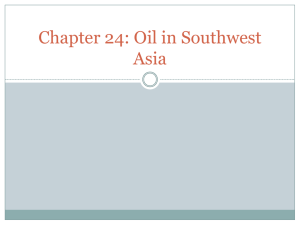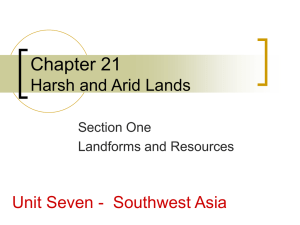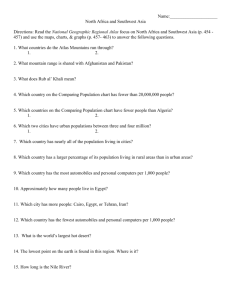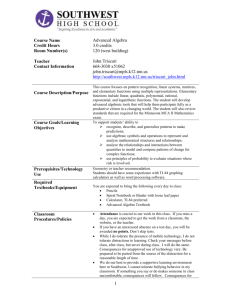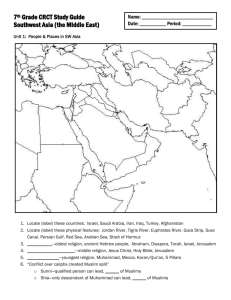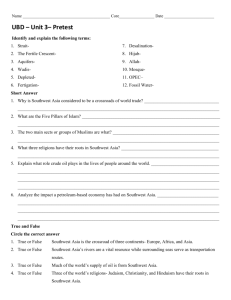Chapter 24 Oil in Southwest Asia
advertisement
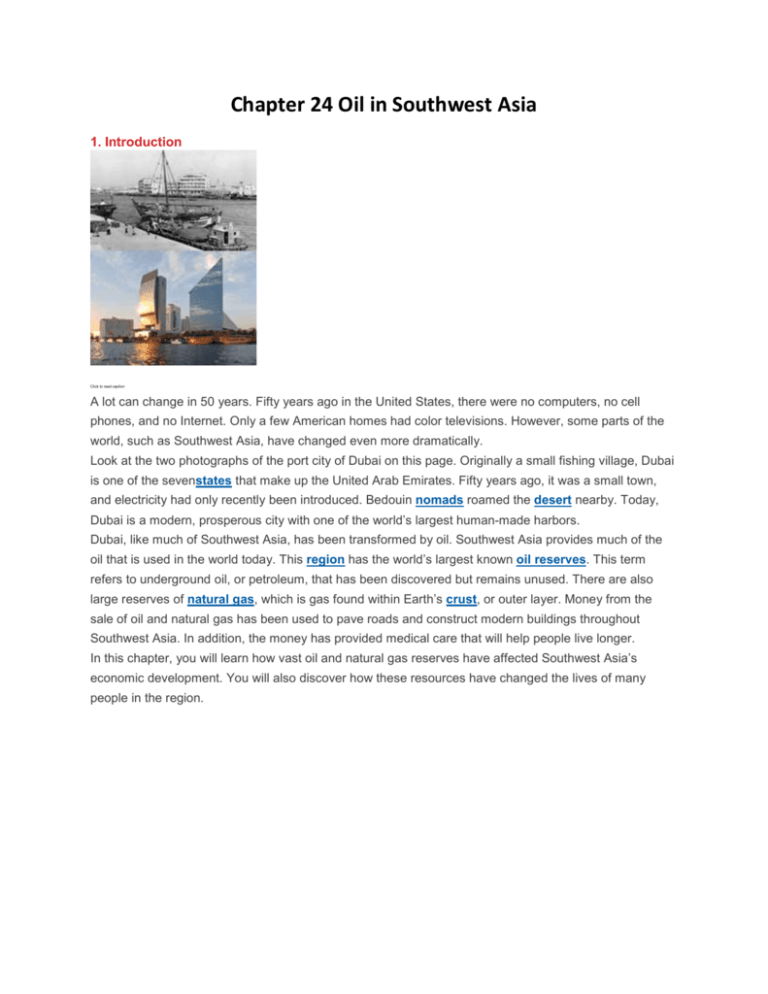
Chapter 24 Oil in Southwest Asia 1. Introduction Click to read caption A lot can change in 50 years. Fifty years ago in the United States, there were no computers, no cell phones, and no Internet. Only a few American homes had color televisions. However, some parts of the world, such as Southwest Asia, have changed even more dramatically. Look at the two photographs of the port city of Dubai on this page. Originally a small fishing village, Dubai is one of the sevenstates that make up the United Arab Emirates. Fifty years ago, it was a small town, and electricity had only recently been introduced. Bedouin nomads roamed the desert nearby. Today, Dubai is a modern, prosperous city with one of the world’s largest human-made harbors. Dubai, like much of Southwest Asia, has been transformed by oil. Southwest Asia provides much of the oil that is used in the world today. This region has the world’s largest known oil reserves. This term refers to underground oil, or petroleum, that has been discovered but remains unused. There are also large reserves of natural gas, which is gas found within Earth’s crust, or outer layer. Money from the sale of oil and natural gas has been used to pave roads and construct modern buildings throughout Southwest Asia. In addition, the money has provided medical care that will help people live longer. In this chapter, you will learn how vast oil and natural gas reserves have affected Southwest Asia’s economic development. You will also discover how these resources have changed the lives of many people in the region. 2. The Geographic Setting Click to read caption Southwest Asia lies at the crossroads of three continents: Europe, Africa, and Asia. During ancient times, this location brought traders from distant lands to this region. Most traveled by land over dusty caravan routes. Traders from all over the world still come to Southwest Asia today. However, now many of them arrive in huge tanker ships and are looking for only one product: oil. Oil: Southwest Asia’s Hidden Treasure On the surface, Southwest Asia doesn’t look very welcoming. Much of the region is hot and dry. The Arabian Desert is so barren that some people call it “the place where no one comes out.” However, hidden beneath the region’s deserts are vast reserves of oil and natural gas. More than half of the world’s proven crude oil reserves lie under Southwest Asia. Crude oil is another name for petroleum as it is found in the ground. Proven crude oil reserves are known deposits that can be pumped to the surface at a reasonable cost. Worldwide demand is high for oil and natural gas. Developed countries depend on these fuels to meet most of their energy needs. Modern forms of transportation run mainly on oil. Power plants burn oil and natural gas to generate electricity. Oil is also a raw material that is used to make plastics, medicines, and other goods. Some of the countries in Southwest Asia have grown rich meeting the world’s ever-growing demand for oil. Although Southwest Asia has large oil reserves, it lacks other resources. Fresh water, for example, is in short supply throughout the region. Moreover, oil is anonrenewable resource. In other words, there is only a limited amount of it. Once the world’s supply of oil is used up, it can’t be replaced. Click to read caption When the supply of oil is gone, the world will have to rely on renewable resources. This term refers to resources that will not run out or resources that can be replaced. Three examples of renewable energy resources are sunlight, wind, and geothermal energy, which is heat energy drawn from inside Earth. Waterpower and trees are two other renewable resources. Many Ethnic Groups, One Major Religion Most of the people who live in Southwest Asia are Arabs, people who speak Arabic. Other major ethnic groups include the Kurds and the Persians.The Kurds live in parts of Turkey, Syria, Iraq, and Iran, whereas the great majority of Persians live in Iran. Islam is the most important religion in Southwest Asia. Only one country in the region, Israel, does not have a Muslim majority. There are, however, several branches of Islam. Conflict among different ethnic and religious groups has led to unrest and violence. In this chapter, you will look at how oil has shaped the development of 10 countries in Southwest Asia. These countries differ in area and population, but each of them has large oil reserves, and each has used oil in different ways to meet its people’s needs. These countries are Bahrain, Iran, Iraq, Kuwait, Oman, Qatar, Saudi Arabia, Syria, United Arab Emirates, and Yemen. For most Americans, oil comes from a gas station, which is where they typically purchase oil to lubricate their car engines. To power those engines, they also buy gasoline made from oil. In some regions of the United States, people also heat their homes by burning oil. The oil that Americans burn in their cars and homes took a long time to form, and more often than not, that oil has traveled a very long distance to reach this country. Click to read caption Oil Was Formed Millions of Years Ago The oil that is pumped out of the ground today was formed a very long time ago. It began as tiny plants and animals that lived and died in the oceans. After they died, these creatures sank to the ocean floor. Over time, most of their remains were transformed into rock. Layer after layer of rock was formed in this manner. However, some of these plant and animal remains did not turn into rock. The weight of the water, heat from Earth’s core, and chemical changes combined to transform some of the remains of these creatures into oil and natural gas. Over time, the oil and natural gas seeped into pores, or tiny holes, within the layers of rock. These pores may be too small to see, but they are large enough to hold oil and gas, in much the same way that a sponge holds water. At times, some of this oil or gas has risen to Earth’s surface. However, most of it remains trapped underneath a layer ofimpermeable rock. Impermeable means “preventing the passage of liquid or gas.” Geologists call this layer a cap rock because it functions like the cap on a container. This cap rock keeps most of the oil and natural gas contained deep inside the earth. Click to read caption Oil Is Found in Pockets Deep in the Earth A great amount of the world’s oil lies buried under Southwest Asia. One reason for these large deposits is that millions of years ago this area was under water. The sea that covered the region contained the tiny plants and animals that began the process of making oil. Another reason that oil formed underneath Southwest Asia has to do with the movement of Earth’s crust. You read in Chapter 17 that Earth’s crust is broken into giant sections called tectonic plates. These plates have continued to drift very slowly over the surface of Earth. When two tectonic plates collide, they may create pockets where oil can form. This is what happened in Southwest Asia very long ago. The Iranian Plate and the Arabian Plate bumped up against each other, creating spaces where oil and gas were formed and trapped. It takes extensive effort to get oil out of underground pores and pockets. Oil companies must drill through the cap rock to get at the oil underneath. Then they pump the oil up to the surface. However, sometimes this pumping process is not successful. When that happens, petroleum engineers inject water or gases into the well, creating added pressure to force the oil out of the rocks. The oil that reaches Earth’s surface doesn’t look much like the gasoline or oil that people purchase at their local gas station. Crude oil is usually combined with water and natural gas when it comes out of the ground. Oil companies have to refine this crude oil to make it into gasoline and other useful products. Some other petroleum products are asphalt, plastics, and the wax used to make candles. Oil Is Not Distributed Equally Since very specific conditions were necessary for the production of oil, it is not surprising that these conditions existed in some places but not in others. Southwest Asia was one of the regions where an enormous amount of oil formed long ago. Within Southwest Asia, however, the distribution of oil is uneven. Saudi Arabia is the largest country in this region, and it also has the most oil. In fact, approximately one quarter of the world’s proven oil reserves lie under its desert sand. Kuwait, in contrast, is a tiny country. Saudi Arabia could contain 125 Kuwaits and still have space left over, but little Kuwait holds almost a tenth of the world’s known oil reserves. Other countries in Southwest Asia, such as Syria and Yemen, have less oil, but they still have more oil than most other countries in the world. 4. Oil Wealth and People’s Well-Being Click to read caption Oil has made the royal family of Saudi Arabia extremely wealthy. Consider the expensive vacation the royal family took in 2002.King Fahd and about 3,000 guests visited the town of Marbella, which is on the southern coast of Spain. The royal family spent about $185 million preparing a palace in Marbella for the vacation. Among the expenses was the cost of hiring hundreds of attendants. After the king arrived, he requested daily flower deliveries, with each delivery running approximately $1,500. Few people in Saudi Arabia have such a luxurious lifestyle. Just as some countries have more oil reserves than others, some of the people living in oil-rich countries have much more wealth than others. Click to read caption Oil Has Made Many People Better Off In general, oil money has improved the lives of many people in Southwest Asia. In 2002, researchers from the United Nations studied changes in the region over the past 30 years. These researchers determined that life expectancy has increased by 15 years and that the number of infants who die in their first year of life, or the infant mortality rate, has fallen by two thirds. There is no doubt that oil has made some countries rich, but just how rich? There are two common methods to measure a country’s wealth. The first method is to examine a country’s gross domestic product, or GDP. As you read in Chapter 7, GDP is a measure of all the goods and services produced by a country each year. The second method of determining a country’s wealth is to look at the per capita GDP, which measures the average income of the people in a country. To calculate this per-person GDP figure, divide the total GDP by the number of people in the country. Per capita GDP varies extensively from country to country for many reasons. The United Arab Emirates and Kuwait, for example, both have a high GDP from selling oil. Since both of these countries also have small populations, they both have a per capita GDP that is relatively high.Countries with larger populations, such as Saudi Arabia and Iran, have to divide their GDP among many more people, thereby resulting in a lower per capita GDP. Bahrain, in contrast, has far smaller oil reserves than the other oil-rich countries of Southwest Asia.Nevertheless, its per capita GDP is quite high because the country earns much of its GDP by processing, instead of pumping, crude oil. Bahrain’s wealth has also increased as a result of the country’s development into an international banking center. Click to read caption Per Capita GDP Does Not Tell the Whole Story Per capita GDP is an average, which assumes that a country’s wealth is divided equally among its citizens. In reality, however, some people may be extremely rich, whereas many of their fellow citizens remain quite poor. Accordingly, per capita GDP doesn’t always reflect the general well-being of the people of a country. Another method of measuring how well people are living in a country is the United Nations’ Human Development Index (HDI). As you read in Chapter 9, the HDI examines a country’s per capita GDP along with other factors that reflect the general quality of life.One of these factors is life expectancy. Another significant factor is education. How many of the people are literate—that is, how many know how to read? How many of the children have received a high school education? When these numbers are evaluated, countries are ranked from best to worst, with 1 being best. Based on the HDI, Bahrain is third in Southwest Asia in terms of living well. Although Bahrain does not have the most oil or the highest per capita GDP in Southwest Asia, the country does use its wealth to educate its population. Almost all of its young people, both boys and girls, attend school. Bahrain also invests in health care. The infant mortality rate in Bahrain is one of the lowest in Southwest Asia. As you have read, the infant mortality rate is the number of deaths of babies under age one that occur for every 1,000 births in a year. Oil Has Not Improved Life for All Money from selling oil hasn’t eliminated poverty in Southwest Asia. Yemen, for example, remains one of the 60 poorest countries in the world. Although its population is approximately 80 percent of the population of Saudi Arabia, its oil reserves are only about 1 percent the size of those in Saudi Arabia. This means that the amount of oil produced by Yemen each year has not been sufficient to pull its people out of poverty. Other Southwest Asian countries have made considerable money from oil, but they have not used that money to improve people’s lives. For example, Iraq has the second-largest oil reserves in the region, but from 1979 to 2003, a dictator named Saddam Hussein controlled Iraq’s oil income. He spent most of Iraq’s oil wealth building an army, buying weapons, and fighting wars. Very little of the money went to make life better for ordinary Iraqis. 5. The Price and Flow of Oil Click to read caption Thick black smoke filled the sky, darkening what had been a bright, sunny day. Kuwait’s oil fields were on fire. The year was 1991, and Iraq had invaded Kuwait in an effort to take over its oil reserves. This invasion led to a conflict known as the Persian Gulf War. When the war ended, retreating Iraqi troops torched some of Kuwait’s oil wells. The Persian Gulf War was one of many conflicts over oil in Southwest Asia. These conflicts have involved both oil-exporting countries and oil-importing countries. Oil-Exporting Countries: Working to Control the Price of Oil Most oil-exporting countries depend on oil sales to support their economies. Therefore, one of their goals is to have a steady supply of oil flowing out of their countries. In return for their oil, they expect a steady flow of money to come back into their countries. To ensure a steady supply of oil and a steady income, several oil-exporting countries formed the Organization of the Petroleum Exporting Countries (OPEC) in 1960.In 2009, OPEC had 12 member countries. Six members were Southwest Asian countries, but the organization includes six oil producers from outside the region:Algeria, Angola, Ecuador, Libya, Nigeria, and Venezuela. Meanwhile, not all of the Southwest Asian oil producers belong to OPEC. Bahrain, Yemen, Oman, and Syria have not joined the organization. OPEC wants oil prices to be steady—not too high and not too low. If too much oil is offered for sale, there will be less competition among buyers to purchase the oil they need. As a result, prices will drop too low. On the other hand, if too little oil is offered for sale, there will be more competition between buyers, causing prices to rise too high. In order to keep prices steady, OPEC members have agreed to regulate how much oil they will sell. However, two realities limit OPEC’s ability to control oil prices. First, OPEC cannot control all of the world’s oil sales because its members export less than half of the world’s crude oil. The rest of the crude oil comes from non-OPEC countries such as Russia and Mexico. Second, even OPEC members don’t always act as a united group. For example, sometimes some members refuse to follow OPEC decisions on how much oil to sell. Click to read caption Oil-Importing Countries: Working to Protect the Flow of Oil Other countries depend on the flow of oil from Southwest Asia to fuel their economies. The United States, Japan, and many countries in Europe are huge oil importers and therefore have a strong interest in protecting the flow of oil around the world. As you have read, in 1990 Saddam Hussein, the dictator of Iraq, ordered his military to invade neighboring Kuwait. This invasion gave Saddam Hussein control of Kuwait’s oil fields. Fears grew that the dictator would target Saudi Arabia next. If Iraq took over Saudi Arabia, Saddam would control much of the world’s oil supply. If he then decided to cut off oil sales, many oil-importing countries would suffer severe energy shortages. The United States and many other countries formed a coalition, or alliance, to drive Iraq out of Kuwait. Some members of the coalition were oil-importing countries that did not want their oil supplies threatened by Iraq. Others were oil-exporting countries that feared losing control of their oil reserves to Iraq. The coalition went to war in 1991 to drive Iraqi forces out of Kuwait. The Persian Gulf War lasted just a few weeks. In that time, Kuwait was freed from Iraqi control. The coalition victory sent the world a clear message: as long as oil is the world’s main source of energy, countries that import oil will work to keep it flowing. Summary - Beginning to Think Globally Click to read caption In this chapter, you learned that crude oil forms deep within Earth. Much of Earth’s oil lies under Southwest Asia. However, oil reserves are not distributed evenly among the region’s countries, nor is the wealth from oil sales distributed evenly among the citizens of oil-rich countries. You also learned that oil is a nonrenewable resource. Eventually, the world will run out of oil. Some countries are already developing their renewable resources to meet some of their energy needs. One example is solar energy, which is energy from the sun that can be converted into heat or electricity. As oil runs out, other countries will have to follow their example. Think about this as you examine the map of solar energy in the next section. Global Connections Click to read caption This map shows the distribution of one renewable energy resource, sunlight. The circle graphs show energy produced by renewable and nonrenewable resources in two years. Renewable resources include sunlight, wind, and the power of moving water. They also include plants that can become fuel. Corn, for example, is used to produce a fuel called ethanol, which is mixed with gasoline to burn in cars and trucks that have been designed to run on this alternative fuel. What energy sources is the world using to meet most of its energy needs? What do they have in common? The world is relying mainly on nonrenewable resources to meet its energy needs. All of these energy sources will someday run out. Why isn’t the world getting more of its energy from renewable resources? In the past, generating energy from renewable resources has cost more than burning oil or gas. Hydro electric power was the only renewable resource that could compete with fossil fuels. However, building hydroelectric dams on rivers has been costly and can also harm the environment. Recently the cost of generating electricity from wind has dropped. As a result, many countries are now using wind power to meet some of their energy needs. Click to read caption How might having renewable energy resources affect a region in the future? In the future, sunlight and wind may become key resources. Regions that have daily sunshine or steady winds could become major energy producers. Deserts in the U.S. Southwest are already home to solar power plants. Wind farms are sprouting up across the breezy Great Plains. On these farms, large windmills generate electricity as their blades spin in the wind.
